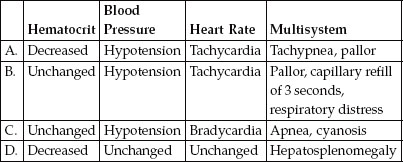Chapter 18 Hematologic Disorders
1. A 32-week, small-for-gestational-age infant is born via primary cesarean section due to a nonreassuring fetal heart tracing. In addition to sending blood samples for TORCH (toxoplasmosis, other infections, rubella, cytomegalovirus infection, and herpes simplex) titers, the physician requests that immunoglobulin levels be determined. In the event of an in utero viral infection, which immunoglobulin level would be elevated in the period immediately after birth?
2. A 26-year-old primigravida was found to have pregnancy-induced hypertension at 22 weeks’ gestation. After her infant was born at term, the infant was found to have a venous hematocrit of 68%. What is the most likely reason for the polycythemia experienced by this infant?
3. Which of the following infants will show the greatest affinity for oxygen?
4. Compared with adult red blood cells, newborn red blood cells:
5. A 35-week gestational age infant was born in septic shock 36 hours ago. Cultures of blood specimens taken at birth grew out positive for Escherichia coli. The infant has been receiving mechanical ventilation since birth and has required dopamine (14 mcg/kg/minute) and dobutamine (5 mcg/kg/minute). A short while ago, the infant had a sudden pulmonary hemorrhage. Furthermore, he now has petechiae on his trunk. An examination of the maternal laboratory results shows that the platelet count is normal. Based on the history and clinical presentation of this infant, what disease process is occurring?
6. What are the expected laboratory results for a patient with disseminated intravascular coagulation?
7. What blood transfusion product will most directly supply fibrinogen to an infant?
8. Which set of signs and symptoms is most likely to reflect the infant’s condition in the first 30 to 60 minutes following this acute loss of blood?
< div class='tao-gold-member'>
Stay updated, free articles. Join our Telegram channel

Full access? Get Clinical Tree



